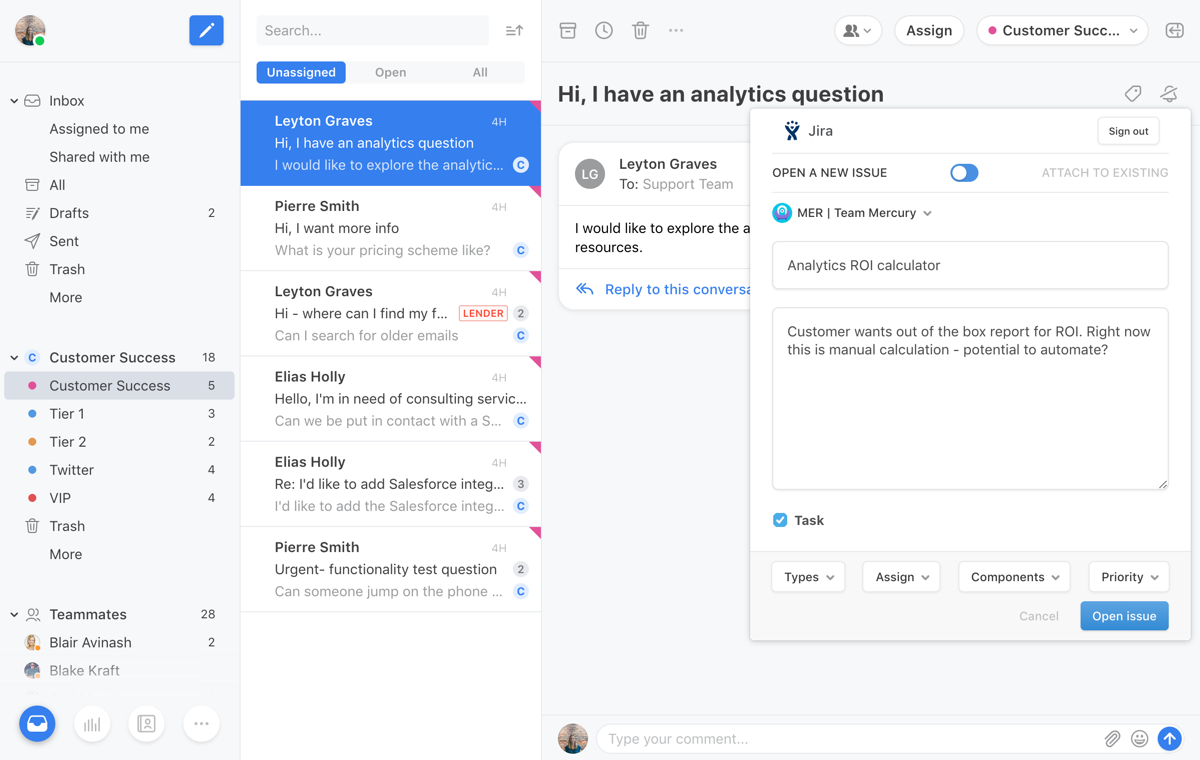Product management is a full circle motion for our team at Front.
The first 180 degrees is all about listening to customers and understanding their needs, so we can solve them with our product. The second half is about closing the loop: communicating to customers what weve done and how were working to meet their needs in the future.
To build product at Front, we not surprisingly use Front. Front allows us to take our product development process full-circle: it connects us with our customers, so we can get context around their needs. It bridges gaps between product and other departments in our company, so we can communicate what were working on to customers. Last, it makes it easy for us to follow up with customers to let them know their issues are solved or get their feedback.
Heres how weve used Front to create a repeatable, customer-driven process for building our product.
1. Listening to customers
We are constantly seeking product feedback from customers through user research calls, customer meetings, and surveys. But beyond actively soliciting customer feedback, we make sure its easy to reach our team. Sometimes the best suggestions and greatest insights come from our customers reaching out on their own, rather than a survey or question we ask them.
Shared inboxes for feedback across the customer lifecycle
Most often, customer feedback comes not to our product team, but directly to our customer-facing teams like support, success, and sales. Thats where shared inboxes in Front save the day.
Having shared access to customer emails in these inboxes allows everyone in the company to get a deeper understanding of our customers needs (and pain points!), rather than siloing this valuable feedback in a single persons inbox.
These shared inboxes are a critical part of our product management toolkit. Our product team gets customer insight to drive product decisions, and many other internal teams browse them to keep a close pulse on customers:
Support@ email inbox
Escalation folders for technical support issues
Live in-app support chat
NPS Survey & Customer feedback
Twitter
In addition, our product team manages its own shared inbox, Product. Any time a teammate has a product question or a feature request from a customer or for themselves they can let us know at product@. When we reply, we typically clarify how a feature works or give a sense of whether its likely to be added to our roadmap. This shared inbox gives our teammates one easy place to reach the us, and also gives the product team visibility into the features people want.
Public roadmap
On our public roadmap, users can find what weve shipped recently, what we are currently working on, and some ideas of what we might work on next. It allows customers to voice their opinions by voting for the features they need most.

Anyone can upvote, so customers can browse and give a thumbs up to any features they want. When we feel like a feature is important enough to be prioritized, we move it into our product pipeline. There, users can follow its progress, from "in the works" to "shipped."
2. Prioritizing customer needs through data
So weve set up a bunch of ways for customers to reach us and express their needs. Next, we have to decide what to build and when. Data and user research drive this, and most of it is driven through Front:
Accessing customer conversations alongside Jira issues
We connect Front to Jira, so when customers make feature requests, we tag those conversations in Front with a corresponding Jira issue that tracks the feature. Now when we are evaluating a feature, we can look at the Jira issue, click through to Front, and find all the conversations in Front that have been linked to the request. We can read our customers words exactly.

When were researching for a feature, our product team can email customers directly to ask more questions. This is often a pleasant surprise for customers especially when they submitted the request months ago. When we ask to hop on a call to better understand customer needs, we have a surprisingly high response rate!
Front analytics on tags
We tag all the feedback we get from customers to keep it organized like 🐛 Bugs or 🌚 Dark theme, for instance. But the real kicker here is that with Fronts analytics, we can access data and track trends on each tagged feature to see whos requesting it and the volume of requests, for example.
We can reference data from customer conversations connected to each Jira issue or tag, so our roadmapping and planning exercises are more informed and systematic.
3. Closing the loop
The last part of the product management process that we find to be SO important here at Front is closing the loop with customers when we ship something they requested. Closing the loop establishes trust, and it lets your customers know that youre listening, working, and dedicated to serving them.
Theres a two-way sync between Jira and Front. When we ship a feature and close the Jira issue, every conversation linked to that issue gets reopened for our customer success and support teams. That way we can update every customer when a feature they asked about ships.
Because of Front, we are able to let customers know when something theyve asked for has launched, without having to remember or write it down individually. Our customers have said it feels like magic: Whoa, you remembered I asked for this 9 months ago?! Nice!
💡 Got an idea? Submit a feature request or upvote an existing one.
Written by Ailian Gan
Originally Published: 17 April 2020

